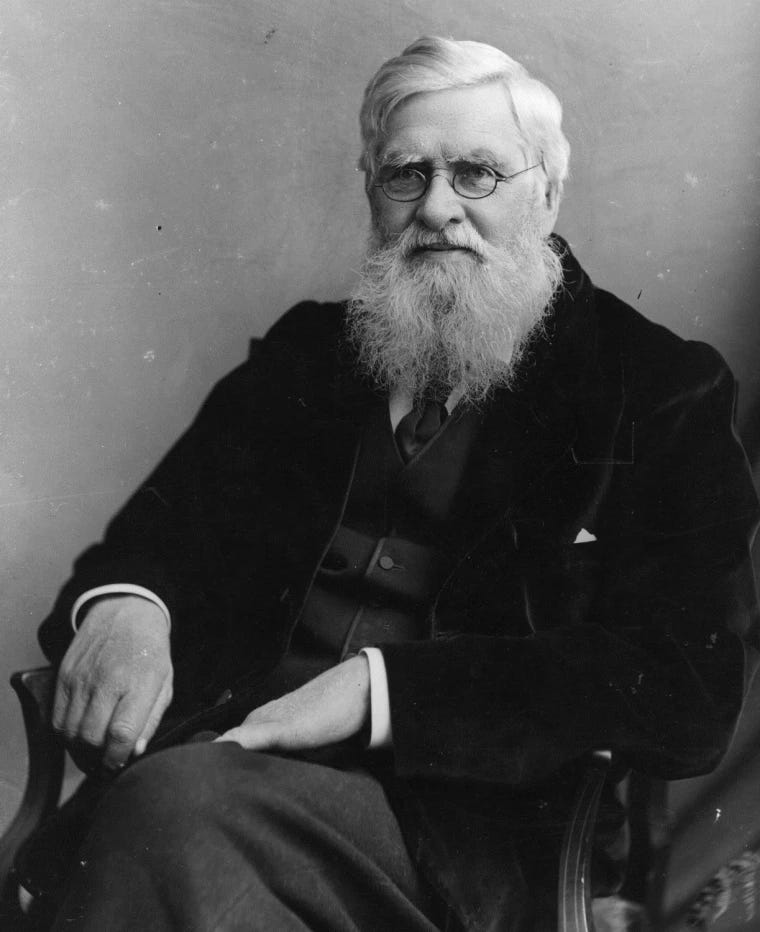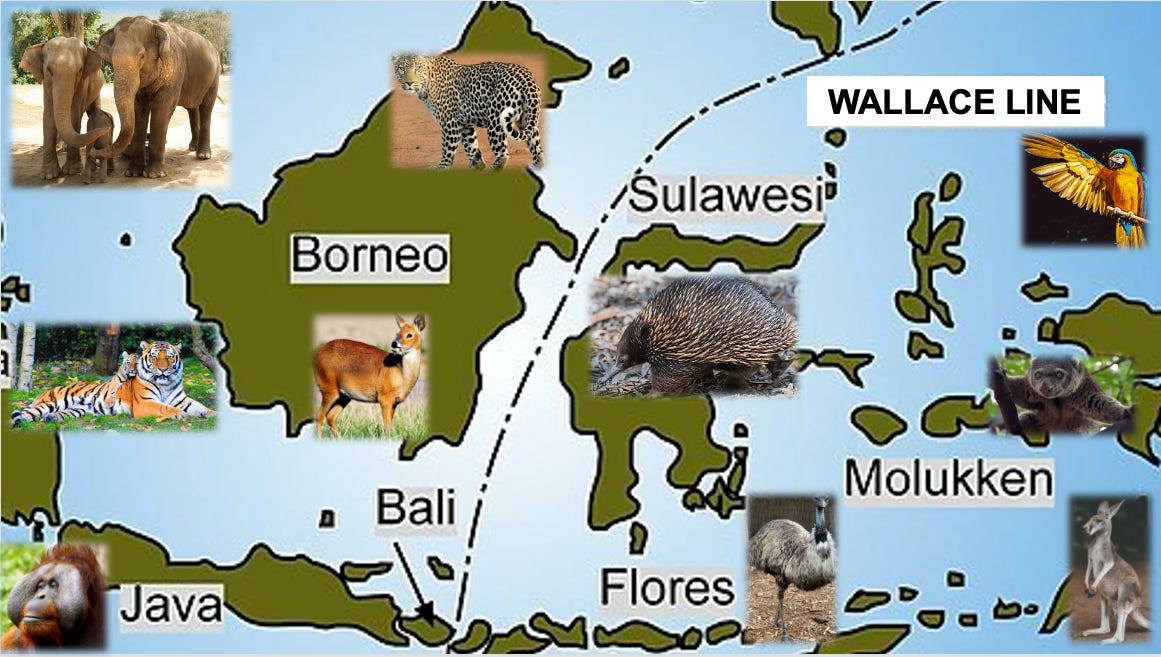The Wallace Line: The Great Divide in Nature
The Secret Border that Separates Asia and Australia
During my journey into the fascinating world of nature, I recently stumbled upon an old truth that felt entirely new to me: the Wallace Line. This invisible boundary, named after the British naturalist Alfred Russel Wallace, was first drawn in 1859 and remains a cornerstone in the study of biogeography. Stretching through the Malay Archipelago, it delineates the faunal realms of Asia and Australia. Wallace, a contemporary of Charles Darwin, is celebrated for his independent conception of natural selection and his profound insights into the geographical distribution of species.
As I delved into the history and implications of the Wallace Line, I was filled with wonder at the stark differences in wildlife on either side, shaped by millennia of geological forces such as tectonic activity and sea-level changes. This discovery not only broadened my understanding of biodiversity but also ignited a profound appreciation for the intricate tapestry of life on our planet.

A Journey Through the Malay Archipelago
Wallace's travels through the Malay Archipelago, a sprawling chain of over 25,000 islands between Southeast Asia and Australia, were pivotal in his recognition of this boundary. As he meticulously documented the flora and fauna, he observed a stark contrast in species composition on either side of what would become known as the Wallace Line. This boundary is defined by deep-water channels that have historically acted as barriers, preventing the migration of species and leading to distinct evolutionary paths.
To the west, the fauna is predominantly of Asian origin, featuring a variety of species typically associated with the Asian mainland, including elephants; tigers and leopards; hoofed mammals such as deer and wild cattle; and primates such as orangutans, macaques, and gibbons. In contrast, to the east, the fauna is a mix of Asian and Australian origins, with a significant presence of species unique to Australasia, such as kangaroos and cuscus; monotremes like the echidna; and birds like cockatoos and other parrots, as well as ratites like emus and cassowaries.

Between these two realms lies Wallacea, a unique transitional zone that contains a blend of species from both sides, adding another layer of complexity to the region's biodiversity. This area highlights the intricate tapestry of life shaped by geological and evolutionary forces, underscoring the significance of Wallace's discoveries in our understanding of biogeography.
Geological and Natural Selection Underpinnings
The Wallace Line is not merely a geographical curiosity but a profound reflection of deep geological and natural selection processes. This boundary traces a deep-water channel that has historically acted as a formidable barrier to species migration. During the Pleistocene epoch, when global sea levels were significantly lower, many islands were connected, yet the deep waters of the Wallace Line remained an unyielding divide. This separation prevented the mingling of species from the Asian and Australian continental shelves, leading to distinct evolutionary paths and contributing to the unique biodiversity of the region known as Wallacea.
The geological complexity of the region, situated at the convergence of several tectonic plates, further underscores the significance of the Wallace Line. The deep-water channels along this boundary, with average depths of 250 meters, create strong currents and high winds, effectively blocking passage to all but the most capable swimmers. This has resulted in ecosystems on either side of the line evolving in isolation over millennia, fostering unique biological communities.
Wallace's observations and subsequent discoveries opened a new field of biogeography, exploring how geographical features, whether modern, ancient, visible, or hidden, affect the distribution of living organisms. His work laid the foundation for understanding the tremendous complexity that defines the natural world and continues to influence scientific thought to this day.
Modern Implications and Scientific Exploration
Today, the Wallace Line continues to intrigue scientists and ecologists, serving as a natural laboratory for understanding species distribution and adaptation. Recent studies have employed advanced computer models to simulate how historical climatic changes influenced species distribution across this boundary. These models reveal that Asian species were better suited to the warmer, wetter climates of the Malay Archipelago, using the islands as stepping stones toward Australia. In contrast, Australian species, adapted to cooler and drier climates, struggled to establish themselves in these tropical environments.
The implications of the Wallace Line extend beyond historical biogeography. It provides insights into how species might respond to contemporary climate change. By studying the line, researchers hope to predict which species may adapt to new environments as Earth's climate continues to evolve. The line's role as a barrier to species migration highlights the importance of understanding geographical and climatic factors in shaping biodiversity.
A Legacy of Discovery
Alfred Russel Wallace's contributions to science are profound, and the Wallace Line stands as a testament to his pioneering spirit. This boundary not only demarcates a division in the physical world but also symbolizes the invisible lines of inquiry and discovery that Wallace pursued throughout his life. During his extensive travels through the Malay Archipelago, Wallace's observations and theories laid the foundation for the field of biogeography and have had a lasting impact on biological sciences. Initially, his work was met with skepticism, but over time, it has gained recognition as a cornerstone of evolutionary biology.
The Wallace Line continues to influence scientific thought, providing insights into the historical distribution of species and the evolutionary processes that shape biodiversity. It serves as a reminder of how ancient geological events and climatic shifts can echo through time, affecting the distribution of life in profound ways. Wallace's discoveries also challenged the prevailing scientific and religious views of his time, prompting a reevaluation of humanity's understanding of the natural world.
As we continue to explore and understand the complexities of our planet's biodiversity, the Wallace Line remains a guiding landmark in the ever-evolving map of life on Earth. Its implications extend beyond historical biogeography, offering valuable insights into contemporary issues such as climate change and species adaptation. By studying this ancient boundary, researchers can better predict how species might respond to new environmental challenges, ensuring that Wallace's legacy of discovery continues to inspire and inform future generations.
Ed Boks is a former Executive Director of the New York City, Los Angeles, and Maricopa County Animal Care & Control Departments. His work has been published in the LA Times, New York Times, Newsweek, Real Clear Policy, Sentient Media, and now on Animal Politics with Ed Boks. He is available for consultations at animalpolitics8@gmail.com





Another new topic to me. Fun to learn about.
enlightening